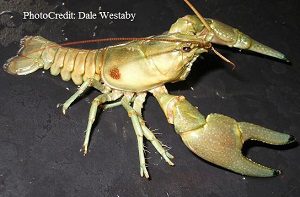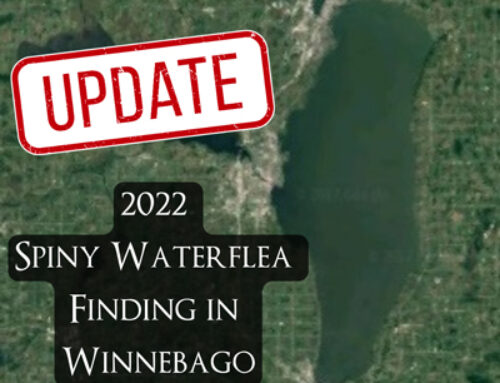Every month, we will put a spotlight on an aquatic invasive species in a re-occurring monthly article. Check it out!
Rusty Crayfish – Aggressive Red Bully!
Rusty crayfish (Orconectes rusticus) are native to lakes and streams in Kentucky, Ohio, Illinois, and Indiana but have invaded many surrounding states including Wisconsin and into the Winnebago Waterways. This species continues to spread into more lakes and rivers most often through anglers who use rusty crayfish as live bait and don’t dispose of them properly. 
Rusty crayfish are easily distinguishable from native crayfish species by their red, rust colored spots on each side of the carapace. These spots are located behind the claws where you would pick up the crayfish. In fact, these spots are about the size of a human fingerprint! Imagine you had red paint on your fingers when you picked up a crayfish and that’s where you would find the rusty red spots where this AIS gets its name! In addition the rusty crayfish has larger claws than its native counterparts.
In the Winnebago Waterways, rusty crayfish have been found in Lakes Winnebago, Butte des Morts, Winneconne, and Poygan as well as many inland streams. As opportunistic feeders, rusty crayfish appetites include fish eggs, small fish, insects, aquatic plants, and detritus (decaying plants and animals).
Rusty crayfish may cause numerous economic and ecological impacts when they are established in a lake or stream. The crayfish is very aggressive and pushes native species out of habitat. These displaced native crayfish are more exposed and more likely to be eaten by predators. However, the most significant impact is the destruction of aquatic vegetation caused by the rusty crayfish. Rusty crayfish have been documented as reducing aquatic plant abundance and species diversity. These crayfish have a higher metabolic rate, larger appetite, and grow larger than native species. In addition, rusty crayfish tend to destroy plants by cutting plant stems when feeding, As a result a large portion of the plant than floats away. For other species such as the invasive Eurasian watermilfoil (EWM) that can form new plants when piece of the plant float away, rusty crayfish can actually cause more dispersal of EWM.
Crayfish are often collected as bait or food in Wisconsin and this may be the only use for this AIS. You are allowed to use crayfish as bait as long as the crayfish were caught from the water body being trapped, were obtained from a bait dealer, or were used with written authorization from the Wisconsin Department of Natural Resources (DNR). A WI DNR permit is needed in order to take crayfish. However, it is illegal to fish with live crayfish or possess live crayfish and angling equipment on any water except the Mississippi River.
 While rusty crayfish are often introduced through illegal bait dumps (as previously mentioned), this AIS can also spread into new lakes and rivers through several other methods. Crayfish, including rusty crayfish, are often sold to schools through biological supply houses. While there is a warning against releasing any of the crayfish included with every shipment, warnings may be ignored/forgotten. Often the school children are given a crayfish to take home. These crayfish may be released as soon as the child gets home or perhaps the crayfish end up in aquariums that eventually get dumped into local lakes and rivers. Since rusty crayfish are a sexual reproductive species, may people often ask if there is a risk to a waterbody if only one rusty crayfish is accidentally introduced into a new system. However, the life history of rusty crayfish allows females to store sperm until they are ready to release their eggs. So having just one rusty crayfish to a new waterbody can start a new population. To make matters even more complicated, rusty crayfish are prolific breeders with each female crayfish releasing 80 – 575 eggs!
While rusty crayfish are often introduced through illegal bait dumps (as previously mentioned), this AIS can also spread into new lakes and rivers through several other methods. Crayfish, including rusty crayfish, are often sold to schools through biological supply houses. While there is a warning against releasing any of the crayfish included with every shipment, warnings may be ignored/forgotten. Often the school children are given a crayfish to take home. These crayfish may be released as soon as the child gets home or perhaps the crayfish end up in aquariums that eventually get dumped into local lakes and rivers. Since rusty crayfish are a sexual reproductive species, may people often ask if there is a risk to a waterbody if only one rusty crayfish is accidentally introduced into a new system. However, the life history of rusty crayfish allows females to store sperm until they are ready to release their eggs. So having just one rusty crayfish to a new waterbody can start a new population. To make matters even more complicated, rusty crayfish are prolific breeders with each female crayfish releasing 80 – 575 eggs!
In Wisconsin, rusty crayfish are classified as a Restricted Species meaning that it is already established in the state and has the ability to cause significant environmental, economic, or human health harm.
HELP PREVENT THE SPREAD!
Every time you come off the water, make sure to follow these steps to stop the spread of rusty crayfish and other aquatic invasive species:
* Inspect boats, trailers and equipment for attached aquatic plants or animals.
* Remove all attached plants or animals
* Drain all water from boats, motors, livewells and other equipment
* Never move live fish away from a waterbody
* Dispose of unwanted bait in the trash and never release aquarium plants or animals into your local waterways
* Buy minnows from a Wisconsin bait dealer.
* Only use leftover minnows when either 1) fishing with them on the same body of water or 2) on other waters if no lake/river water or other fish have been added to the container.
Follow the Fox Wolf Watershed Alliance’s Winnebago Waterways Program on our Winnebago Waterways Facebook page or @WinnWaterways on Twitter! You can also sign-up for email updates at WinnebagoWaterways.org.
This article was written by Chris Acy, the AIS Coordinator for the Winnebago Waterways Program covering Fond du Lac, Calumet, and Winnebago Counties.
To learn more about invasive species and their impacts to Wisconsin’s waters and economy, visit DNR.wi.gov and search “Invasive Species”.
Questions? Comments? Contact Chris Acy, our Aquatic Invasive Species Coordinator at (920) 460-3674 or chris@fwwa.org!
Winnebago Waterways is a Fox-Wolf Watershed Alliance program. The Fox-Wolf Watershed Alliance is an independent nonprofit organization that identifies and advocates effective policies and actions that protect, restore, and sustain water resources in the Fox-Wolf River Basin.





